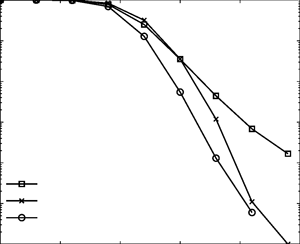Improved VBLAST MAP: A novel point-to-point symbol detection algorithm for MIMO wireless communication systems
DOI:
https://doi.org/10.3103/S0735272718050023Keywords:
multiple input multiple output, MIMO, minimum mean square error, MMSE, vertical Bell laboratories layered space-time maximum a posteriori probabilities, VBLAST MAP, improved VBLASTAbstract
A novel point-to-point symbol detection algorithm in multiple input multiple output (MIMO) system is proposed. This algorithm is an augmentation of two popular algorithms, namely, vertical Bell laboratories layered space-time (VBLAST) and maximum a posteriori probability (MAP). Here, layers are distinguished or ordered based on the a posteriori probabilities of output symbols and not on signal-to-noise ratio (SNR). For each layer, a set of a posteriori probabilities is computed for all output symbols using all possible signal constellations. The layer corresponding to the output symbol having minimum a posteriori probability is selected first from the set of a posteriori probabilities for detection by doing the comprehensive search over all the possible signal constellations. Then, the remaining layers are detected by the conventional VBLAST MAP technique. The relationship of MIMO symbol error rate (MIMO SER) versus MIMO symbol SNR is presented using simulations for 16x16 MIMO systems and 16-QAM constellation. The results show that the proposed algorithm outperforms conventional VBLAST MAP and improved VBLAST algorithms.References
- FOSCHINI, G.J. “Layered space-time architecture for wireless communication in a fading environment when using multi-element antennas,” Bell Labs Tech. J., v.1, n.2, p.41-59, Autumn 1996. DOI: https://doi.org/10.1002/bltj.2015.
- ARGELL, E.; ERIKSSON, T.; VARDY, A.; ZEGER, K. “Closest point search in lattices,” IEEE Trans. Inf. Theory, v.48, n.8, p.2201-2214, Aug. 2002. DOI: https://doi.org/10.1109/TIT.2002.800499.
- GUPTA, Vipul; SAH, Abhay Kumar; CHATURVEDI, A.K. “Approximate matrix inversion based low complexity sphere decoding in MIMO systems,” 8 Sept. 2015. URI: https://arxiv.org/abs/1509.02405.
- KANTHIMATHI, M.; AMUTHA, R. “Reduced complexity maximum likelihood detection for DAPSK based relay communication systems,” Proc. of Int. Conf. on Computing and Communications Technologies, ICCCT, 26-27 Feb. 2015, Chennai, India. IEEE, 2015. DOI: https://doi.org/10.1109/ICCCT2.2015.7292763.
- GOLDEN, G.D.; FOSCHINI, C.J.; VALENZUELA, R.A.; WOLNIANSKY, P.W. “Detection algorithm and initial laboratory results using V-BLAST space-time communication architecture,” Electron. Lett., v.35, n.1, p.14-16, Jan. 1999. DOI: http://dx.doi.org/10.1049/el:19990058.
- YAPICI, Yavuz. “A new symbol detection algorithm for MIMO channels,” A thesis submitted to the department of electrical and electronics engineering.InstituteofEngineeringand Science of Bilkent University, Jan. 2005.
- WOLNIANSKY, P.W.; FOSCHINI, G.J.; GOLDEN, G.D.; VALENZUELA, R.A. “V-BLAST: An architecture for realizing very high data rates over the rich-scattering wireless channel,” Proc. of Int. Symp. on Signals, Systems, and Electronics, 2 Oct. 1998, Pisa, Italy. IEEE, 1998, p.295-300. DOI: https://doi.org/10.1109/ISSSE.1998.738086.
- ALIMOHAMMAD, A.; FARD, S.F.; COCKBURN, B.F. “Improved layered MIMO detection algorithm with near-optimal performance,” Electron. Lett., v.45, n.13, p.675-677, 18 June 2009. DOI: http://dx.doi.org/10.1049/el.2009.0373.
- CHAUHAN, D.V.; BHALANI, J.K. “Performance of nonlinear detectors in spatial multiplexing for spatially correlated channels,” Radioelectron. Commun. Syst., v.60, n.7, p.297-302, 2017. DOI: https://doi.org/10.3103/S0735272717070020.

Downloads
Published
2018-05-24
Issue
Section
Research Articles

